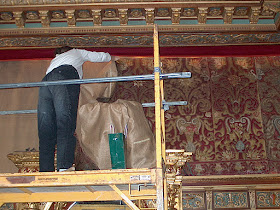ARCA Washington DC Correspondent
Part one
In 2002 the Turkish government launched the renovation of the 1606 23rd Street, NW mansion; every detail both structural and decorative. It took four years. I served on a team consisting of an architect, engineer, designer, curator, conservators and appraisers evaluating the ballroom wall hangings. The main question was how much life remains? Could they be aesthetically and structurally restored to validate the cost of conservation? Discussions included possible replacement with reproduction weavings from high scale design houses, to simulate the overall look but not historic techniques. Another option considered was having new ‘embroideries’ produced in Turkey. (Could that even be done?) Concerns about the structural integrity of the walls to prevent future damage were hammered out. Since the entire mansion was going to have a grand face lift, these textiles had to meet the same aesthetic bar. Otherwise, the inclination was for retirement and replacement with in a newer look, a ‘proven’ longer term wall treatment.
 |
| Detail of stains |
As a conservator, I truly valued the historic importance of the fabrics. If they were retired, they would never be seen again. It was a long shot that money would be spent to reproduce them accurately. And while not fully proven, I believe they are original to the house and date to circa 1880-1900. In fact, the wall fabrics have not been definitively dated. (No written records were found.) One appraiser in 2002 concluded that they were a mid-century Ottoman style of embroidery and wall covering. While we can conclude that they were installed in situ circa 1914, they could have been cannibalized and cut from earlier 19th century wall coverings from Turkey. Since architect George Totten had lived and worked in Turkey, it is not inconceivable that he purchased these specifically for the ballroom. They are an extraordinary complex technique of appliqué of silk sateen cutouts (think Matisse) on top of contrasting silk sateen ground, with each large motif outlined with a cording that was stitched and glued on. The pattern, an architectural niche containing a tall bulbous ‘vase’ shapes, alternates the red and gold silk, so the eye moves along as if following a series of decorative windows. Within each ‘vase’ or ‘tree of life’ elaborate floral bouquets are embroidered in blues, pinks, yellows and reds. More than 12 genus correct floral bouquets were identified throughout the fabrics. In spite of the blackened stains, holes and losses, the fabrics were definitely worth preserving.
 |
| Inserting silk panels |
 |
| De-installing panels in 2003 |
Tents were used for military campaigns, state ceremonies, outings, personal ceremonies, daily housing, and of course by tribal groups. The Ottoman army had extensive tents, elaborately decorated to project power, prestige and comfort. The walls of the tents were formed by rectangular textile panels sewn together, and the number of panels depended on the size of the tent. They were crafted to recreate tiled panels in a room or pavilion. (Atasoy) Depending on rank, the tent had various degrees of decoration. Some were richly encrusted, with silks, and sparkling threads and embossed leather.
Atasoy, Nurhan. “Otag-I Humanyan: The Ottoman Imperial Tent Complex, Aygaz”, Istanbul, 2000.
Atasoy, Nurhan. “The Ottoman Tent”, www.turkishculture.org
Part two of this series will resume tomorrow on this blog.
Julia M. Brennan graduated from ARCA's International Art Crime Studies program in 2009.
www.caringfortextiles.com


No comments:
Post a Comment